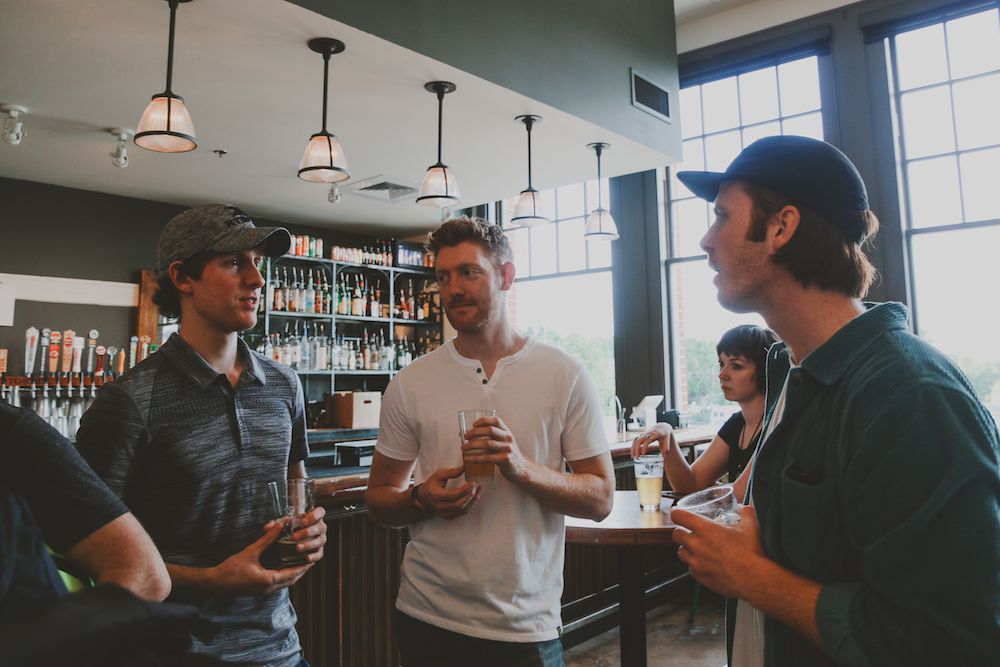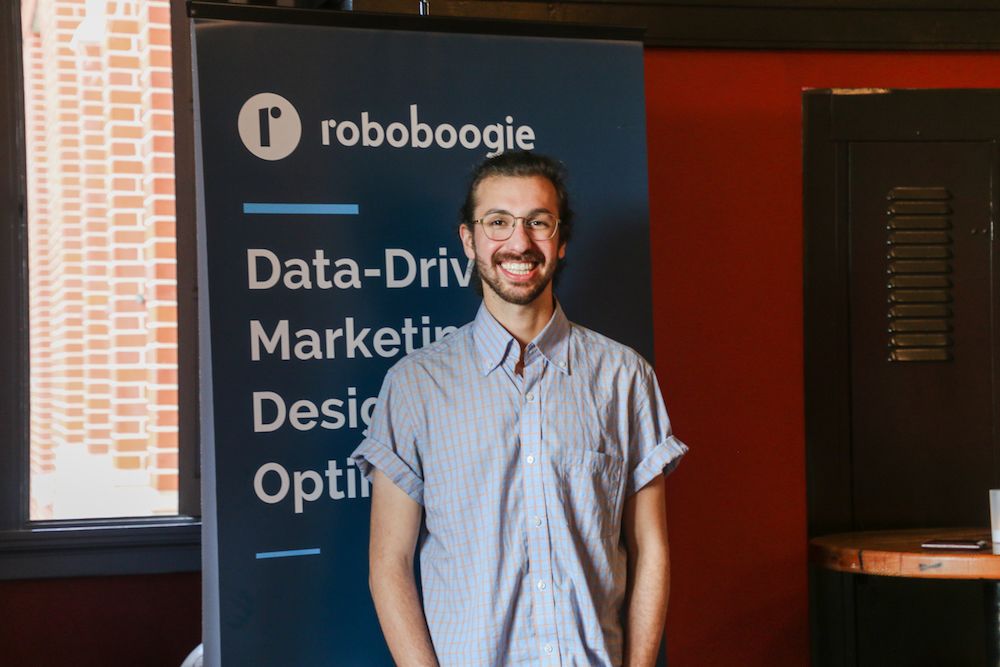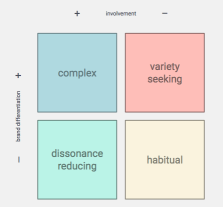Go Back
On May 24th, roboboogie’s Camp Optimization hosted Aaron Stusser, eCommerce Manager at Yakima Products, who spoke about the applying the theory of Buying Decision Behavior to digital content creation. Aaron discussed the psychology behind buying decision behavior in order to highlight how brands can make smarter content to drive conversions.

By breaking down consumers into different buying behavior groups, Aaron matched each group with a distinct content strategy in order to assist companies with serving content that would encourage their customers to convert. His presentation was insightful and engaging, and prompted compelling brand-specific conversations from the audience. If you missed the talk, don’t worry. We’ve outlined our top buying decision behavior takeaways from our event!
Introducing Aaron Stusser
Before jumping into the world of consumer behavior and purchasing practices, let us introduce our May Camp Optimization speaker. Aaron is an eCommerce Manager at Yakima Products. His focus revolves around directing consumers to the information that is important to them, in the easiest way possible. Aaron has background in consumer behavior, copywriting, and eCommerce.

Rules About Consumers
In today’s crowded digital landscape, consumers’ buying behaviors are often dictated by the connection they feel with a brand. This means content has a powerful ability to drive customers’ relationships with brands to new levels, forging fresh perspectives and opinions about the brands attached to the products they are purchasing. By understanding where their target customers fall with a certain purchasing group, brands can effectively craft content to drive sales.
Aaron began his presentation by stating four rules that he has uncovered over his years in content marketing, to help frame up the Buying Decision Behavior theory. Each rule corresponds directly to how he interpreted content strategies:
- People Vary
- Markets Move
- People Change
- Consumers Care

The Theory: Buying Decision Behavior
Buying Decision Behavior is a marketing theory developed in the 1980s by Henry Assael. The theory splits consumers into four distinct groups, defined by their levels of perceived brand differentiation (how users compare similar brands and perceive their differences) in relation to their level of involvement (time, energy, etc. spent researching a purchase). In order to create content that will have the greatest impact on customers, brands must first identify which category of buying behavior their target consumers align with in relation to their product or service offering. By identifying how target customers shop, brands can optimize content to maximize engagement and help consumers feel supported in their purchase process. Buying decision behavior dives into the psychological habits and motivations behind each customer’s buying decision process, and if you understand these, you can directly address their needs.
Aaron identified four main types of consumers based on buying behavior: complex, dissonance reducing, variety seeking and habitual.
- Complex buying behavior is characterized by high involvement and high perceived brand differentiation. People often shop for cars, phones, and other electronics with complex buying behavior. Types of content that work best: in-depth, highly descriptive, inviting, theatrical, elaborate, competitive.
- Dissonance reducing buying behavior is characterized by high involvement and low perceived brand differentiation. People often search for car mechanics or other high-value services with dissonance reducing buying behavior. Types of content that work best: storytelling, representative, guarantee, affirming, value, support, acclaim.
- Variety seeking buying behavior is characterized by low involvement and high perceived brand differentiation. People often shop for cereal or other snacks at the grocery store with variety seeking buying behavior. Types of content that work best: differentiation, improvements, simple, forward, confident, something new.
- Habitual buying behavior is characterized by low involvement and low perceived brand differentiation. People often shop for commodities like salt or toilet paper with habitual buying behavior. Types of content that work best: consistency, same-or-better, confident, forward, simple.
If brands can group their target consumers into one of these purchasing groups, they can then begin to craft content that appeals to their motivations. As Aaron emphasized, everyone shops differently, and everyone puts different levels of involvement into choosing brands. This applies to every type of purchase, from buying weekly groceries to purchasing a car. Aaron presented four strategies to help put the right content in front of the right consumers, and to aid in getting the most out of Buying Decision Behavior.
Strategy #1: Cover Your Bases
This strategy highlights the importance of not putting all your content into a singular quadrant. Instead, use strategies other than the most common for your product or service offering, to reach consumers who simply shop differently for the same thing. For example, if you are selling a product like a new computer, emphasize guarantees, warranties, and customer support in order to effectively appeal to dissonance reducing consumers, in addition to the more common complex consumers.
Strategy #2: Move Your Market
The second strategy, move your market, is all about changing the way consumers perceive, and therefore shop for, your product. Aaron talks about how some markets, regardless of content strategy, are extremely difficult to win. Products like peanut butter, laundry detergent and cereal are dominated by incredibly large players who overtake the selection of options. These products often fall in the habitual quadrant, so the recommendation here would be to aim content at creating perceived brand differentiation where there normally would be little-to-none.
For instance, Proctor & Gamble’s Tide brand controlled 70% of laundry detergent industry last year. Persil, an up-and-coming competitor, used variety seeking content strategies in order to move the market and stay afloat. By emphasizing product features and elements that appealed to the variety seeking group, Persil was able to directly influence variety seeking customers and see increased market share for their brand.

Strategy #3: Hold Steady
The third strategy, hold steady, revolves around holding your ground, and really speaking to how the majority of consumers shop for your product or service. For example, habitual purchasers have a singular goal when shopping: to buy the product they know and use. Aaron stated that the number one way to target habitual purchasers is to hold steady with your content marketing. People habitually buy the same brand of salt, ketchup, paper towels, and so on because the packaging, messaging and content is familiar and clear.
Tropicana rebelled against this strategy by releasing a newly branded orange juice bottle, which ended up causing a 20% drop in sales. The reason? Consumers could no longer immediately recognize the product, and with low brand loyalty in the habitual space, simply opted for the next most familiar bottle.
Strategy #4: Innovate
The final strategy is focused on innovation for the future. Finding ways to engage and excite customers by the process of experimentation is vital. Continue trying new content strategies to see what works with different consumers. Use data as a baseline for measuring results, and iterate towards the most effective solution.

Great Content makes Happy Customers Convert
After Aaron shared each of his four strategies with us, he concluded by commenting that the most important thing content marketers should be focused on is designing for their target customers. By connecting with the customer, you are not only learning more about their needs, but realizing how your story can impact their decision to convert based on what you choose to highlight in the brand’s content.
Thank you, Aaron, for an incredible and informative event! Curious about our next Camp Optimization event? Save the date for Thursday, July 26th at Washington High School. See you there!



